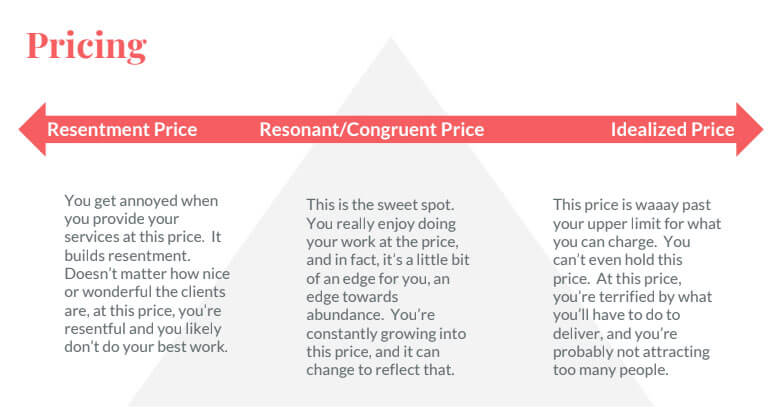How to Be More Confident and Charge What You’re Worth
Pricing is always a challenge for freelancers. How can you set a price that works for you and your business? One of the dangers is something called resentment pricing: Charging too little and devaluing your work and your clients. [pullquote]Undervaluing your business leads to resentment. That's why it's a good idea to review your pricing and charge what you're really worth.
Pricing is always a challenge for freelancers. How can you set a price that works for you and your business? One of the dangers is something called resentment pricing: Charging too little and devaluing your work and your clients.
 [pullquote]Undervaluing your business leads to resentment. That’s why it’s a good idea to review your pricing and charge what you’re really worth. [/pullquote]
[pullquote]Undervaluing your business leads to resentment. That’s why it’s a good idea to review your pricing and charge what you’re really worth. [/pullquote]

 [pullquote]Undervaluing your business leads to resentment. That’s why it’s a good idea to review your pricing and charge what you’re really worth. [/pullquote]
[pullquote]Undervaluing your business leads to resentment. That’s why it’s a good idea to review your pricing and charge what you’re really worth. [/pullquote]
The Pricing Continuum
During our recent Resentment vs. Resonant Pricing webinars, business coach Diane Whiddon shared a continuum that your prices are going to fall into. It’s not based on dollar amount, but on how your pricing works for your business. This is more about how pricing feels and the impact that has on your business.
What is Resentment Pricing?
On the low end of the continuum is resentment pricing. You’re not getting paid what you know you’re worth. This type of pricing annoys you and literally builds resentment. Resentment pricing is about how your pricing makes you feel. This might seem like an odd way to approach it—shouldn’t we be laser-focused on cut and dry details like math? But we’re emotional beings, and we tend to make decisions based on our emotions. And how we feel can have a profound impact on our work and our effectiveness. So it really does matter. Your clients also stand to lose with resentment pricing. They recognize that you’re undervaluing your work and they treat you accordingly. They don’t come prepared for meetings or even blow them off entirely. The cost is so low they don’t take you seriously.Idealized Pricing
On the opposite end is idealized pricing. Idealized pricing is way more than you should be charging, to the point that you feel like a fraud. You feel like you have to deliver such value at this price, and you’re not even sure you can do that. Instead of the extra income giving you comfort, it causes panic. Idealized pricing is a lot less common of a problem, but it is the opposite end of the continuum.Resonant/Congruent Pricing
In the middle is your sweet spot: resonant pricing. This is the price you want. You’re really happy to work at this price, you know you’re making what you’re worth and you’re delivering value that’s worth this price. This price resonates with you. What’s so perfect about this price is that it energizes you. You’re being well compensated, so you’re not worried about money and fretting about hourly math. Instead, you’re focused on the job, and that means delivering better work.Recognize Where You Are
[pullquote]You need to recognize where you are on the pricing continuum and make the appropriate changes.[/pullquote] If your profit margins keeps getting tighter and you’re feeling less accomplished, you’re going to resent it. That means you’re not as engaged in your work and you’re probably not delivering the best work you can. It’s a negative cycle that can kill your business.The way out is to charge more. Raise your prices. This is the most common advice freelancers need to hear.If you’re having trouble recognizing where you land on the continuum, think about what you would charge your best client ever. Then think about what you would charge your worst client ever. There’s likely a difference. (There are some clients that can’t pay you enough to work for them again.) Working with those respective clients gives you certain feelings (one great, one horrible), and it impacts the price.
Pricing Changes
Where you land on the resentment pricing continuum will change over time, so you’ll need to reevaluate and adjust. You get better every day—your skills advance, you get more experience, and you figure out better ways of doing things. Your future clients benefit from all that growth, and it makes you more valuable. So you need to charge more. If you don’t raise your prices as your experience grows (or even keep up with inflation), you’ll start to slide toward resentment. What was once a fair, comfortable price will start to feel more like a squeeze.Be Confident & Charge What You’re Worth
Often, pricing is a confidence issue for freelancers. The way to avoid resentment pricing is to be more confident. If you’re struggling with confidence, ask your best customers what they most value about working with you. If you feel like you need an excuse to ask for that (well, then you definitely have a confidence problem), you could do it in the context of asking for testimonials. If you’re still feeling a crisis of confidence, the Imposter Syndrome Quiz might be another helpful way for you to come to terms with this issue.Find Pricing That Works
If you’re struggling with resentment pricing, it’s time to make a change. Watch the entire webinar Resonant v. Resentment Pricing: How to Set Prices That Support You and Your Business with business coach Diane Whiddon to learn more. She covers this continuum of pricing, as well as a range of other issues about how we relate to pricing and money. You can also check out some of our recent posts on pricing:Sign up now — Get SolidWP updates and valuable content straight to your inbox
Sign up
Placeholder text
Placeholder text
Get started with confidence — risk free, guaranteed